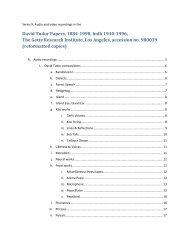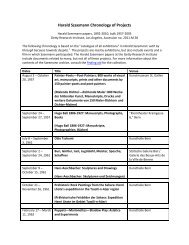Pierre Courthion Biography by Amy Cubicciotti Pierre ... - The Getty
Pierre Courthion Biography by Amy Cubicciotti Pierre ... - The Getty
Pierre Courthion Biography by Amy Cubicciotti Pierre ... - The Getty
You also want an ePaper? Increase the reach of your titles
YUMPU automatically turns print PDFs into web optimized ePapers that Google loves.
<strong>Pierre</strong> <strong>Courthion</strong> <strong>Biography</strong> <strong>by</strong> <strong>Amy</strong> <strong>Cubicciotti</strong><br />
<strong>Pierre</strong> <strong>Courthion</strong> Papers, <strong>The</strong> <strong>Getty</strong> Research Institute, Los Angeles, Accession no. 890007<br />
<strong>Pierre</strong> <strong>Courthion</strong> was born in Geneva on January 14, 1902 to Louis and Elisa <strong>Courthion</strong>. His father was a<br />
writer and editor of the local newspaper, the Journal de Gèneve. <strong>Courthion</strong> attended secondary school<br />
in Schwyz, Switzerland. He then attended the Université de Gèneve and received a scholarship to study<br />
painting at the École des Beaux-Arts in Paris, where he became acquainted with and developed<br />
friendships with artists such as Alberto Giacometti and Kurt Seligmann. While in Paris, <strong>Courthion</strong> spent<br />
time in Montmartre and encountered many of the artists living and working there, some of whom would<br />
be the focus of his later publications. At the age of 19, <strong>Courthion</strong> was traveled to Italy. He would later<br />
marry <strong>Pierre</strong>tte, a woman of Swiss descent, and welcome the birth of his daughter, Sabine. <strong>Courthion</strong><br />
was a student at the Louvre and did his doctoral work on the painter, Jean-Étienne Liotard. During<br />
World War II, <strong>Pierre</strong> and his wife fled to Geneva and participated in the resistance and later in his life,<br />
<strong>Courthion</strong> visited Auschwitz. In 1950, <strong>Pierre</strong> <strong>Courthion</strong> became a citizen of France. He lived and worked<br />
in France for most of his life. He died in 1988 at the age of 86.<br />
Other seminal activities in <strong>Courthion</strong>’s life include his service as a functionary of the Society of Nations.<br />
In 1934, <strong>Courthion</strong> was named archaéologue cantonal of Valais and director of the Musée<br />
Archéologique de Valère. He served as the director of the Swiss Foundation at the Cité Universitaire of<br />
Paris from 1933-1939. He was also vice-president of the Syndicat de la presse artistique française,<br />
founding member of the Association internationale des critiques d’art (AICA), and member of the<br />
Société des ecrivans suisses. <strong>Courthion</strong> received several prestigious awards.<br />
Over the course of his career, <strong>Courthion</strong> traveled widely. He performed research, participated in<br />
professional activities and gave conferences and lectures around the world from Europe and the U.S. to<br />
Brazil and Venezuela and Japan and Korea. In the U.S., <strong>Courthion</strong> participated as a member of the jury<br />
for the prestigious Guggenheim Prize of 1960.<br />
Writing Career and Achievements:<br />
<strong>Courthion</strong> began his professional career in Paris as an editor of the journal, L’Éclair. Surrounded <strong>by</strong> the<br />
art of Paris and Montparnasse, <strong>Courthion</strong> got his start as a critique d’art. His monographs, contributions<br />
and direction of reviews, catalogs, contributions and collaborations began appearing en masse after<br />
1925 and received widespread international acclaim. <strong>Courthion</strong> not only associated with artists, but<br />
also with well-known writers and poets such as Ramuz, <strong>Pierre</strong>-Jean Jouve, Marcel Raymond, Albert<br />
Béguin, Maurice Chappaz, and Henri Michaux, many of whom contributed to one of the reviews he<br />
directed, Lettres, which was published in Geneva between 1943-1947. He was also the director of the<br />
collection, Le cri de la France (1943-1948) and the sixteen-volume collection, Les grands artistes<br />
racontés (vus) par eux-mêmes et leurs amis (1945-1960). <strong>Courthion</strong>’s major projects focused on the<br />
history of French and European art, the history and art of France, Paris and Montmartre, Romanticism<br />
and Realism, and the history of the Impressionist movement, Swiss art, American art, and the<br />
contemporary art of his time.<br />
<strong>Courthion</strong> researched and wrote prodigiously. His writings on 19th and 20th century art attest especially<br />
to the inspiration he drew from the artistic climate of Paris and his associations with notable artists,<br />
1
<strong>Pierre</strong> <strong>Courthion</strong> <strong>Biography</strong> <strong>by</strong> <strong>Amy</strong> <strong>Cubicciotti</strong><br />
<strong>Pierre</strong> <strong>Courthion</strong> Papers, <strong>The</strong> <strong>Getty</strong> Research Institute, Los Angeles, Accession no. 890007<br />
writers and cultural figures of the time. In <strong>Courthion</strong>’s autobiography, he recounts some of his most<br />
formative and memorable experiences, along with his acquaintance with artistic, literary and cultural<br />
luminaries and political dignitaries such as Fernand Léger, André Lhote, Zadkine, Ramuz, Giorgio de<br />
Chirico, Salvador Dali and Artaud, Jacques Villon, Marcel DuChamp, Pablo Gargallo, Hans Arp, Eugenio<br />
D'Ors, and René Auberjonois. Later acquaintainces and interviews included Herman Hesse and Carl<br />
Jung, Pablo Picasso, Henri Matisse, <strong>Pierre</strong> Bonnard, Jean Lurçat, Alberto Giacometti, Nicolas de Staël,<br />
Georges Braque, Raoul Dufy, Blaise Cendrars, Olivier Debré, Robert Lacoste, Georges Rouault, Léon Zack<br />
and Maurice Estève. <strong>Courthion</strong> heavily researched many other artists of his time such as Gino Severini,<br />
Elena Schiavi, Chaîm Soutine, Iberê Camargo and Llorens Artigas.<br />
Publications:<br />
Some of <strong>Courthion</strong>'s major published works were Montmartre (1956), Paris d’autrefois : [de Fouquet à<br />
Daumier] (1957), Paris des temps nouveaux : de l'impressionnisme à nos jours (1957), Le Romanticisme<br />
(1961), Édouard Manet (1962), Georges Rouault (1962), Autour de l'impressionnisme: Bazille, Boudin,<br />
Mary Cassatt, Fantin-Latour, Guigou, Lebourg, Guillaumin, Jongkind, Lépine, Berthe Morisot, Prins, Sisley<br />
(1964), Georges Seurat (1968). Other of <strong>Courthion</strong>'s publications, collaborations and catalogs covered<br />
20th century artists such as Paul Klee, Olivier Debré, André Lhote, Gustav Bolin, Fernand Dubuis, Nicolas<br />
de Stäel, Charles Rollier, Giorgio de Chirico, René Auberjonois, Elena Schiavi, Léon Zack, Kim Whanki,<br />
Paul Franck, Bang Haï-Ja, Frank da Costa, Marc Janson, Afro, Etienne Hajdu, Berto Lardera, Henry Moore,<br />
Arnold Fiedler, Llorens Artigas, Maurice Estève, Bella Karawaewa Prado, and Sergio Telles.<br />
Audiovisual projects included films about Rouault (1967), Ingres (1967) and Soutine (1973), preparation<br />
for a film project about Manet and the encyclopédie visuelle (a book accompanied <strong>by</strong> slides) - L'école de<br />
Paris: de Picasso à nos jours (1973).<br />
For a complete bibliography of <strong>Pierre</strong> <strong>Courthion</strong>’s works, consult his autobiography which was published<br />
after his death: <strong>Courthion</strong>, <strong>Pierre</strong>, D’une palette à l’autre: mémoires d’un critique d’art (Gen ve a<br />
aconni re /arts, 2004).<br />
2





